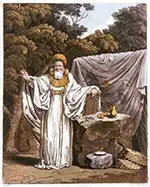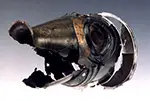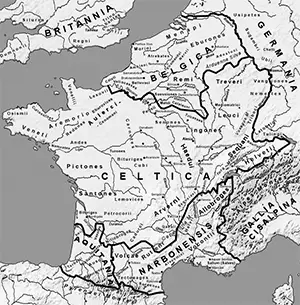The Gauls
Part 1: Gallic Traditions
Gauls, by and large, lived in independent tribes, each with a chief magistrate. The people shared a common language, for the most part, which was spoken much more than written. Because the Gauls wrote so little, what is known of them comes primarily from their conquerors. They minted their own coins, sometimes made of gold and usually showing the face of a warrior chieftain. 
To the Gauls, warfare was a way of life. Because the warriors, nearly always men, were away from home a lot, their families made use of slaves to work the land, run the shops, manage the households, and otherwise keep the economy running. The extent of that economy varied, however, because the Gauls were largely a migratory people, living in one place for a time and then moving on to seek better opportunities. As such, they lived in houses that had basic walls and thatched roofs. Gauls ate much meat but also consumed bread and dairy products. The men, especially, consumed large amount of ale and wine. Bards and harpists performed at a variety of festivals. For entertainment, they enjoyed horse racing, hunting, and field sports. One popular board games, fidchell, resembled chess. 
Inheriting the Celtic culture, Gauls embraced a religion that emphasized the outdoors. With its leaders the Druids, this religion featured gods and goddesses who controlled physical aspects of the world (a belief shared by Romans). Animism was quite strong as well, with many idols in the form boars, dogs, horses, and stags representing the various deities. Most important of all were the birds, from whom divine messages came. The Gauls had a strong artistic tradition, exemplified not only by jewelry but also by decorations of everyday items, such as cauldrons and wine flagons. Not to be outdone, warriors had intricate designs carved into their weapons. A common depiction on Gallic art was the horse. They much preferred individual combat and often did not wear armor, preferring to use their weapons–daggers, spears, and swords–as a means of defense. They proudly rode horses and rode in chariots, as a means of warfare. The prowess of Gallic cavalry was known throughout Europe. The Gauls were loud fighters, making war noises during their combat but also before, in an attempt to intimidate the opponent. 
The Celts admired the wild boar for its fierceness, and Iron Age Celtic warriors wielded a metal war trumpet, called a Carynx, as a call to battle. Blowing in this trumpet produced a loud hoarse scream. The jointed jaws also moved. The effect would have been unnerving even for those who had seen it before. Some sources say that the Celts also played such horns on less violent occasions, like weddings and funerals and feasts and festivals. The Carynx was primarily known as a battle device, however. Next page > Conflicts with Rome > Page 1, 2, 3, 4 |
|
Social Studies for Kids
copyright 2002–2024
David White



 The Gauls were of Celtic origin and comprised a number of different tribes of people who settled in what is now Austria, Belgium, France, Germany, Italy, Luxembourg, the Netherlands, Portugal, Spain, and Switzerland. They are known to have migrated from Central Europe in the 8th Century B.C.
The Gauls were of Celtic origin and comprised a number of different tribes of people who settled in what is now Austria, Belgium, France, Germany, Italy, Luxembourg, the Netherlands, Portugal, Spain, and Switzerland. They are known to have migrated from Central Europe in the 8th Century B.C.
